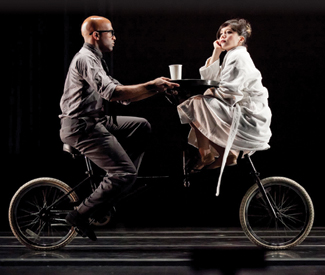arts@sfbg.com
YEAR IN DANCE Looking back on 2012’s over 500 performances — as calculated by Dancers’ Group — the game of “best” and “worst” makes less sense than ever. What makes the Bay Area a place worth living in is the vitality of its arts, and dance in particular. We only have one superstar company, San Francisco Ballet, but we’ve got a number of excellent mid-size ensembles and just enough of a competitive environment to discourage rank amateurism.
Whether for financial reasons or a desire to forego the demands of conventional stage presentations, dancers have continued their exodus to galleries and museums, like the San Francisco Museum of Modern Art, the Asian Art Museum, the California Academy of Sciences, and the de Young Museum. But they have also presented work in public spaces: City Hall, Market Street, Union Square, and Golden Gate Park. These performances necessitate the rethinking of formal parameters, but also reach out to new audiences.
Here are ten companies and artists who challenged expectations or unveiled surprises (at least to me) in 2012. Surprises from young artists are the norm, but experienced choreographers have a far more difficult task when it comes to catching viewers off-guard.
In the middle of March (and after 40 years of rethinking time, space, and motion), Eiko and Koma presented their most radical performance yet. With the breathtaking Fragile, a four-hour meditation in which they moved perhaps two feet, they stretched every conceivable theatrical concept beyond where it could reasonably be expected to go. It was mesmerizing, though I kept wondering where Fragile would be without the wondrous collage of music that David Harrington had assembled for his Kronos Quartet.
Keith Hennessy’s Turbulence (a dance about the economy), a many-tentacled creature that sprawled and oozed its way through Yerba Buena Center for the Arts, was one of the year’s most controversial premieres. No easy viewing, it showed that, for all his passion to redesign the social order, Hennessy is still working on creating new vehicles into which to pour his content. Gratifyingly, Hennessy just received a USA Fellows Award, one of only five Bay Area choreographers to have been so honored.
Monique Jenkinson’s splendid solo Instrument just finished its run at CounterPULSE. It needs to come back. She’s known as Fauxnique in her drag alter ego, but there is nothing faux about this dancer-performance artist. In Instrument, perhaps Jenkinson’s finest work yet, she asks questions about the body as a tool and the nature of being on stage. The figure of Rudolf Nureyev gave her the entrance into a witty but also heartbreaking portrayal of what it means to be a performer.
Even if you watch dance a lot, once in a while it happens that somebody pops up that you have never seen — and yet what they show is already excellent. Such was the case with Nicole Klaymoon’s Embodiment and her joyously rocking House Matter. Working with very good modern and hip-hop dancers, plus jazz singer Valerie Troutt and her vocal ensemble, the women created an evening-long piece about how a house can become a home.
Jenny McAllister’s two-year old 13th Floor Dance Theater is the newest incarnation of McAllister’s dance making endeavors. She has been choreographing genuinely funny dance, often sending up popular culture, for a long time. Bloomsbury/It’s Not Real was her first evening-length work. Using reality TV as a format, she came up with a lovingly loony but smart portrait of the lives and loves of that motley crew known as the Bloomsbury Group.
At the end of September, Birju Maharaj, the 74-year-old Kathak virtuoso, packed the Palace of Fine Arts with a primarily Indian audience who sat through a four-plus hour performance of superb dance. Maharaj performs here every couple of years, often with a similar repertoire. And still you sit there and can’t believe your eyes and ear at this gentle, witty, and generous artist playing “games” with someone like Zakir Hussein.
During its 41st home season, ODC/Dance premiered KT Nelson’s Transit. Taking one look at Max Chen’s whimsical bike concoctions, I just knew that they would steal the show — but they didn’t. Nelson used these metamorphosing velocipedes to call to the stage an image of urban life as fast-paced, fluid, and unstable. Yet for all its fractured continuity, Nelson and ODC’s superb dancers seemed to say, it’s a wonderful life.
San Francisco Ballet’s Beau raised more eyebrows than any of its other commissions, as far as I can remember. Longtime guest artist Mark Morris has built up expectations, so people were furious, feeling let down by what they considered thin, slipshod, easy-way-out choreography. My opinion was in the minority — so I’m looking forward to the piece’s return to find out whether what I thought was there, really is.
In the fall, my first encounter with Einstein at the Beach opened my ears and eyes to what I had known as “an opera” by Robert Wilson and Philip Glass. Surprising to see was how its exquisite details and extraordinary stylization owed more to kabuki than opera, and how Lucinda Childs’ choreography fit into it like a jewel set into a frame. For once the hype surrounding a piece did not even approach the reality of the experience.
Dancers around the world know the Venezuelan-born David Zambrano as a superb, idiosyncratic teacher. So his Soul Project, set to a rich selection of blues and soul music, raised questions about his approach to choreography. Using the YBCA’s Forum as a unified space for dancers and audience, Soul’s meandering trajectory — you never knew who would perform what where — made this one of the year’s most intimate experiences. To be a couple of inches away from such different, yet such superb performers doing what they do best was a treat.

